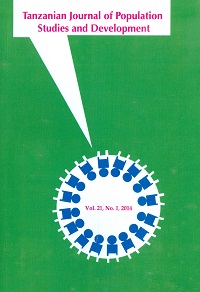Assessment of Traditional Practices Aggravating Maternal Mortality in Temeke District, Tanzania
Abstract
A study to assess traditional practices aggravating maternal mortality in urban and mixed rural-urban populations was carried out in Toangoma and Tandika Wards in Temeke District. Data were collected using questionnaire interviews, un-structured interviews, and in-depth interviews. Data collected were mainly qualitative, and this necessitated use of content analysis. In addition, quantitative analyses were also performed where necessary. Findings indicate that most maternal deaths and complications were associated with cases of anaemia, eclampsia and haemorrhage. The factors behind were more less related to traditional practices. Young age at birth, poor nutrition associated with taboos on types of foods to be eaten during pregnancy, as well as short child spacing instigated by preference of male children were the main factors behind problems related to anaemia and women failure to push during delivery. Also, poverty and lack of control over household resources, male dominated decisions on when and where to seek medical help, and adherence to other cultural norms and values are part of the traditional practices that acted as barriers on women towards seeking modern medical care. Other traditional practices aggravating maternal mortality in the area include belief systems on the causes and cures of diseases. The study recommends that people should be given more modern education about maternal problems associated with over-reliance on traditional practices, right kind information about traditional medicines and herbs, and the discouragement of early marriage to alleviate the problem.
References
AbouZahr, C. 1998. Maternal mortality overview. In: C.J.L Murray & A.D. Lopez (eds). Health Dimensions of Sex and Reproduction. Global Burdens of Disease and Injury Series. Harvard School of Public Health.
AbouZahr C., & E. Royston. 1996. Maternal Mortality. A Global fact book. Geneva: World Health Organization.
Bjørg E., S. Olsen, G. Hinderaker, T. Rolv Lie3, Per Bergsjø4, G. Petro & K. Gunnar. 2002. Maternal mortality in Northern Rural Tanzania: Assessing the completeness of various information sources. University of Bergen, Bergen, Norway.
Conco, W.Z. 1972, The African Bantu Traditional Practices of Medicine: Some Preliminary Observations. Social Science Medicine, Vol. 11, No. 5.
John, C. Caldwell. 1990. Cultural and Social Factors Influencing Mortality Levels in Developing Countries. American Academy of Political & Social Sciences.
Kleinman, A. 1980. ' Patient and Healers in the Context of Culture ' : An Exploration of the borderland between Anthropology Medicine and Psychiatry. Berkeley: University of California Pres.
Maine, D., A. Rosenfield, M. Wallace, A.M. Kimball, B. Kwast, E. Papiernik, & S. White. 1986. Prevention of maternal mortality in developing countries. Background Paper Prepared for the Safe Motherhood Conference, Nairobi, 10-13, February.
Mamady, C. 2003. Levels, Causes and Contributing Factors to Maternal Mortality in Bansang Hospital In Gambia. Thesis for the Master Philosophy Degree in International community Health, Department of General Practice and Community Medicine. Faculty of Medicine, University of Oslon Norway. www.folk.uio.no/ali
National Bureau of Statistics [Tanzania], & ORC Macro. 2005. Tanzania Demographic and Health Survey 2004-2005: Dar es Salaam Tanzania: NBS and ORC Macro.
Okolocha C., J. Chiwuzie, S. Braimoh, J. Unuigbe, & P. Olumeko, 1998. Socio-cultural Factors in Maternal Morbidity and Mortality: A Study of a Semi-Urban Community in Southern Nigeria. Journal of Epidemiology, 52: 293-297.
Okwu A.S.O. 1979. Life, Death, Reincarnation and Traditional Healing Africa. A Quarterly Journal of Opinion, Volume 19 No 3.
PR. 1999. Health Risk Factors of Early Pregnancy. Series Journal Number 41 Vol XXIII, No 3.
Richel, D. 2000. Ignorance, Lack of Funds Push up Maternal Deaths. IPS: Jakarta.
Royston, E., & S. Armstrong. 1989. Preventing Maternal Deaths. Geneva: WHO.
Shaame, A.J. 2005. Causes and Contributing Factors to Maternal Mortality in Zanzibar. The Case of Unguja Hospitals. M.A. Dissertation, University of Dar es Salaam.
Swantz, L. 1990. The Medicine Man Among the Zaramo of Dar es Salaam. Stockholm: The Scandinavian Institute of African Studies.
Thaddeus, S., & D. Maine. 1994. Too far to Walk: Maternal Mortality in Context. Social Science in Medicine 38(8).
UNDP. 2003. Maternal Health Disproportionately High in Developing Countries. Geneva. Accessed through internet website http; www.undp.org.vn/mlist/health/on 20/10/2007
United Republic of Tanzania, Ministry of Health. 1992. Safe Motherhood Strategy for Tanzania. Dar es Salaam: Ministry of Health.
Van de Broek, N. 1996. Pregnancy Related Deaths of West African Women (1). African Medical Journal, 73(3): 164.
Walran, G., Telfer, J. Rowley, & C. Ronsmans. 2000. Maternal Mortality in Rural Gambia. Levels, Causes and Contributing Factors. Bulletin of the WHO. http..folk.uio.no/alie.
Walraven GEL, Mkanje RJB, Van Roosmalen J, Dongen PWJ, Dolman WMV 1994. Assessment of Maternal Mortality in Tanzania. Br J Obs Gyn; 101:414 €“17.
WHO. 2001. Maternal and newborn health/safe motherhood. Geneva Available From: URL:http://www.who.int/rht/msm/msm_indicators.htm
€”. 2004. Progress in Reproductive Health Research. No. 67 Geneva: Switzerland.
€”. 1996. WHO/FRH/MSM/96.11 and UNICEF/PLN/96.1. Geneva.
€”. 1997. Better reproductive health - implementing the global agenda. The Sisterhood method for estimating maternal mortality: Guidance notes for potential users. Geneva: World Health Organization.
€”. 2000. Health Systems Improving Performance. World Health Report. Geneva: Switzerland.
€”. 2001. Maternal mortality in 1995. Estimates developed by WHO, UNICEF, UNFPA.WHO/RHR01.9. Geneva.
€”. 2004. Maternal Mortality in 2000. Estimates developed by WHO, UNICEF and UNFPA. Department of Reproductive Health and Research, Geneva.
WHO/UNICEF. 1990. Estimates of Maternal Mortality: A New Approach by WHO and UNICEF.
Wolfe, K. 2004. Pregnancy Risk Factors: In Encyclopaedia of Diseases and Condition. Health Answers. Inc.
World Bank. 1993. World Development Report: Investing in Health. New York: Oxford University Press.


